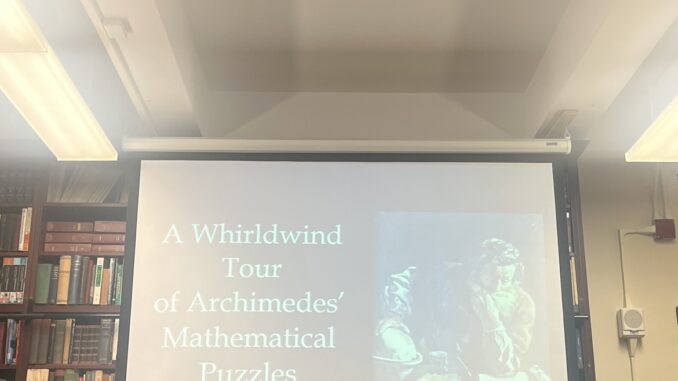
By Paulina Gajewski
Brooklyn College Classics Professor Philip Thibodeau mystified students and professors alike in the Costas Library on Thursday, Nov. 9, with what remains of the puzzles ancient mathematicians and scientists left behind, plenty of which still fascinate scientists today.
Archimedes was born in 287 BCE in the seaport city of Syracuse, Italy. At the time, it was a self-governing colony of Magna Graecia, predominantly made up of southern Italian coastal areas inhabited by Greek settlers. He grew to be well-known for his discoveries in many fields, including mathematics, physics, astronomy, and engineering.
Not much is known about the personal details of his life other than the name of his father, Phidias, which was discovered in one of his puzzles. A contemporary biography had been written about Archimedes by his friend Heracleides, but this work was later lost, leaving only versions of his life written long after his death by historians.
Several anecdotes relating to his discoveries were written after his death. Prior to Archimedes, an individual could only find the volume of a regular object by measuring it, but there had been no way of determining the volume of an irregularly shaped object. Vitruvius, a Roman architect and engineer, provided an origin story for such a revelation.
King Hiero II of Syracuse had received a crown, beautifully welded into the shape of a votive wreath, for which he had supplied the pure gold. Suspecting foul play, Hiero II asked Archimedes to determine whether silver had substituted the real gold. One day, Archimedes stepped into his bathtub, realizing the level of the water had risen significantly, and relating this back to his task.
In this account, Archimedes, so thrilled by his revelation, jumped out of the tub and, forgetting to dress, ran nude through the streets yelling, “Eureka!” (Greek for “I have found it!”); Archimedes managed to prove the suspicions of the king.
Archimedes’ inventions hold much gravity in the ancient world of science, and so do his puzzles. The first of his puzzles is often coined the “Sandman,” based on a series of texts in which Archimedes is writing to King Gelo II of Syracuse. The challenge was to figure out the amount of grains of sand that would fit into the upper bounds of the universe, inherently meaning that he too would have to estimate the size of the universe, and also invent a way to talk about extremely large numbers.
Before Archimedes, the numerical system was constituted of Greek letter notation that spanned from one to 999. Archimedes invented new terminology, the “chiliad,” which is 1,000, and “myriad,” which is 10,000. These new terms would allow for discussions involving larger numbers. He also used the heliocentric model, the model in which the Earth revolves around the sun, and had not been standard.
The second of his puzzles was the “Cattle Problem.” This stemmed from a poem influenced by Homer’s “Odyssey,” in which Odysseus and his men come upon the sacred cattle of the God Helios. Archimedes attempted to estimate the actual number of cattle in the poem. Such a problem includes the study of polynomial equations and has an infinite number of solutions, as you could continue multiplying the equation by an integer to get an even larger number than the last. A solution came about in the nineteenth century, though a computer was able to tackle it around 30 years ago.
The last puzzle was called “Ostomachion,” whose name does not have a singular direct translation; it could mean either “Little Bones” or “Little Stomach Ache.” “Probably because it gives you a stomach ache when you try to solve it,” said Professor Thibodeau.
The origin of the puzzle had remained a mystery for centuries. In 900 CE, a large portion of Greek texts had been translated into Arabic, and much of what we know stems from these translations. This puzzle had been found on a palimpsest, a type of document in which an original text is erased from the page and later reused. In this case, Archimedes’ works had been written over by monks.
This did not mean, however, that the entire Archimedes source had been completely erased. Centuries later, ultraviolet light and scanning were utilized to view the original text. This puzzle dealt with the idea of permutation and involved the amount of rearrangements possible when trying to form a perfect square out of only triangular pieces.
At the end of the lecture, Professor Thibodeau passed around a modern version of such a puzzle, and heads shook in disappointment when it became too complicated. The lecture allowed attendees to connect with the past and reminded them that there are still mysteries from centuries ago left to solve.
